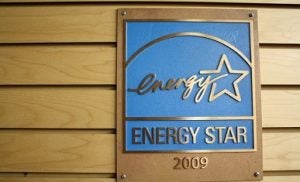The Energy Star Program Saves Americans Billions. So, Why Cut It?
 Evidently, President Trump and his environmental protection chief Scott Pruitt are just getting warmed up.
Evidently, President Trump and his environmental protection chief Scott Pruitt are just getting warmed up.
Now they’ve set their sights on one of the most successful and noncontroversial energy-related programs the U.S. Environmental Protection Agency has ever managed – Energy Star, a program that saves consumers more than $30 billion a year.
According to E&E News, Trump’s draft budget encourages the EPA to “begin developing legislative options and associated groundwork for transferring ownership and implementation of Energy Star to a non-governmental entity.”
Translation: Energy Star, you’re dead.
85% of Americans know Energy Star
If you’ve shopped for a refrigerator, television, washing machine or computer in the last 25 years, you’ve likely run across a product that’s been certified by Energy Star. The voluntary program reviews the energy efficiency of a variety of electronic product categories, and labels the best performers – usually the top 25 percent – Energy Star Certified.
[Tweet “85% of Americans Know and Love the Energy Star Program. So, Why Cut It?”]
It’s a clever concept, like a Good Housekeeping Seal of Approval for energy, but with better measurement and verification. By highlighting a product’s energy performance and projected annual energy cost, Energy Star made energy efficiency a feature.
The EPA says the program has an 85 percent brand recognition rate [PDF], a level most ad execs would kill for.
One of the reasons it has worked so well is its credibility and objectivity.
Program’s transparency, credibility stand out
Customers like it. Manufacturers like it. And it works.
Since Energy Star is government-run, it has the impartiality and transparency that a membership-driven industry organization can’t achieve. A company can’t shove its products through by “donating” to the organization. In fact, you’d be hard pressed to find another government initiative with Energy Star’s credibility.
Over the years, being certified grew into a full-blown marketing advantage for companies with efficient products.
Best Buy brags about being Energy Star’s partner of the year for the past three years in a row. Search for a flat-screen TV on Amazon.com or a refrigerator at Sears.com, and Energy Star is one of the “certifications” you can use to filter your search.
Companies benefit while consumers save
Since its creation, Energy Star has saved consumers $430 billion [PDF] – $34 billion in 2015 alone – and prevented 2.7 billion metric tons of greenhouse gas emissions. Customers like it. Manufacturers like it. And it works.
Not too shabby, especially for a program that is completely voluntary.
Yet, even being a smashing success isn’t enough for President Trump and EPA Administrator Scott Pruitt.
So what happens if they go ahead and kill Energy Star? We’ll see higher electric bills, less competitive manufacturing, wasted energy, more pollution and more sick kids. Is that making America great again?
This post originally appeared on our Voices blog.










